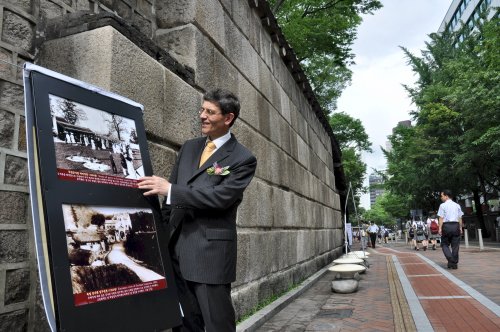If the eyes are the gateway to the soul, then old pictures of Korea are the gateway to Seoul’s history and achievements of the past century.
The German Embassy unveiled a photo exhibition showcasing 40 pictures taken between 1890 to 1920.
“The photos on display are shown for the first time to the public and are very important historical documents. I hope also that in the future there will be more discoveries of important photos helping to understand the history of Korea,” said German Ambassador Hans-Ulrich Seidt.
The ambassador hopes that this photo exhibition will help visitors to Korea to better understand the complex history of the nation.
The German Embassy unveiled a photo exhibition showcasing 40 pictures taken between 1890 to 1920.
“The photos on display are shown for the first time to the public and are very important historical documents. I hope also that in the future there will be more discoveries of important photos helping to understand the history of Korea,” said German Ambassador Hans-Ulrich Seidt.
The ambassador hopes that this photo exhibition will help visitors to Korea to better understand the complex history of the nation.

“How Korea had its first encounter with modernity during the last years of the Joseon (Dynasty) and what developed afterwards,” he said. “It’s enormous to see how Seoul has changed from the early 20th century to the early 21st century. This is unique in history.”
While examining the photos with The Korea Herald, Seidt pointed out details that open one’s eyes to the complex history and achievement of the nation.
“Being a historian, these pictures are becoming more and more important. First, photography was a new medium back then and you could record people in a way that was not possible before.
“It was also a demonstration of the encounter of Korea with modernity,” he said.
One clear change that can be viewed in some of the pictures on display along the outside wall of Deoksu Palace across the street from the Seoul Museum of Art is the deforestation of the hills surrounding what is now downtown Seoul.
“Timber was very important at that time, not only for energy but also to use as building material,” he said.
Another striking photo of the period was a picture of the procession during Emperor Gojong’s abdication in 1907.
“Emperor Gojong is sitting in the carriage accompanied by a large honor guard, but (this is not) the most interesting part of this picture,” he said as he pointed to the bottom right corner of the picture where three Japanese Imperial soldiers were pointing a machine gun toward the procession.
“It’s a historical document showing the sheer oppression behind the political event,” said Seidt.
Another picture showed what might have been the last garden party hosted by the Germany ambassador of the time.
Before the Japanese annexed Korea and told all foreign diplomatic missions to cut ties with the country’s government, the German legation was connected to Deoksu Palace by a small bridge.
The photo exhibition is displayed right where that bridge used to be. The only remnants of the bygone era are different bricks decorating the outside wall of the royal palace.
“This is a wonderful collection of old historic photos contributing to a better understanding of the late Joseon Empire, but also contributing a lot to understand the history of Korea in the early 20th century,” he said.
The photo exhibition will be on display until the end of November.
By Yoav Cerralbo (yoav@heraldcorp.com)








![[Kim Seong-kon] Democracy and the future of South Korea](http://res.heraldm.com/phpwas/restmb_idxmake.php?idx=644&simg=/content/image/2024/04/16/20240416050802_0.jpg&u=)







![[KH Explains] Hyundai's full hybrid edge to pay off amid slow transition to pure EVs](http://res.heraldm.com/phpwas/restmb_idxmake.php?idx=652&simg=/content/image/2024/04/18/20240418050645_0.jpg&u=20240418181020)

![[Today’s K-pop] Zico drops snippet of collaboration with Jennie](http://res.heraldm.com/phpwas/restmb_idxmake.php?idx=642&simg=/content/image/2024/04/18/20240418050702_0.jpg&u=)